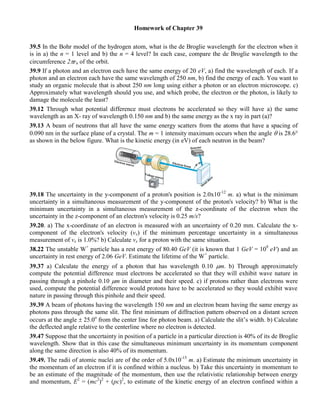
Homework of chapter 39
- 1. Homework of Chapter 39 39.5 In the Bohr model of the hydrogen atom, what is the de Broglie wavelength for the electron when it is in a) the n = 1 level and b) the n = 4 level? In each case, compare the de Broglie wavelength to the circumference 2rn of the orbit. 39.9 If a photon and an electron each have the same energy of 20 eV, a) find the wavelength of each. If a photon and an electron each have the same wavelength of 250 nm, b) find the energy of each. You want to study an organic molecule that is about 250 nm long using either a photon or an electron microscope. c) Approximately what wavelength should you use, and which probe, the electron or the photon, is likely to damage the molecule the least? 39.12 Through what potential difference must electrons be accelerated so they will have a) the same wavelength as an X- ray of wavelength 0.150 nm and b) the same energy as the x ray in part (a)? 39.13 A beam of neutrons that all have the same energy scatters from the atoms that have a spacing of 0.090 nm in the surface plane of a crystal. The m = 1 intensity maximum occurs when the angle is 28.6° as shown in the below figure. What is the kinetic energy (in eV) of each neutron in the beam? 39.18 The uncertainty in the y-component of a proton's position is 2.0x10-12 m. a) what is the minimum uncertainty in a simultaneous measurement of the y-component of the proton's velocity? b) What is the minimum uncertainty in a simultaneous measurement of the z-coordinate of the electron when the uncertainty in the z-component of an electron's velocity is 0.25 m/s? 39.20. a) The x-coordinate of an electron is measured with an uncertainty of 0.20 mm. Calculate the x- component of the electron's velocity (vx) if the minimum percentage uncertainty in a simultaneous measurement of vx is 1.0%? b) Calculate vx for a proton with the same situation. 38.22 The unstable W+ particle has a rest energy of 80.40 GeV (it is known that 1 GeV = 109 eV) and an uncertainty in rest energy of 2.06 GeV. Estimate the lifetime of the W+ particle. 39.37 a) Calculate the energy of a photon that has wavelength 0.10 m. b) Through approximately compute the potential difference must electrons be accelerated so that they will exhibit wave nature in passing through a pinhole 0.10 m in diameter and their speed. c) if protons rather than electrons were used, compute the potential difference would protons have to be accelerated so they would exhibit wave nature in passing through this pinhole and their speed. 39.39 A beam of photons having the wavelength 150 nm and an electron beam having the same energy as photons pass through the same slit. The first minimum of diffraction pattern observed on a distant screen occurs at the angle 25.0o from the center line for photon beam. a) Calculate the slit’s width. b) Calculate the deflected angle relative to the centerline where no electron is detected. 39.47 Suppose that the uncertainty in position of a particle in a particular direction is 40% of its de Broglie wavelength. Show that in this case the simultaneous minimum uncertainty in its momentum component along the same direction is also 40% of its momentum. 39.49. The radii of atomic nuclei are of the order of 5.0x10-15 m. a) Estimate the minimum uncertainty in the momentum of an electron if it is confined within a nucleus. b) Take this uncertainty in momentum to be an estimate of the magnitude of the momentum, then use the relativistic relationship between energy and momentum, E2 = (mc2 )2 + (pc)2 , to estimate of the kinetic energy of an electron confined within a
- 2. nucleus. c) Compare the energy calculated in part (b) to the magnitude of the Coulomb potential energy of a proton and an electron separated by 5.0x10-15 m. 39.53. Suppose that your mass is 60.0 kg and you would have wavelength of 1.0 m to undergo considerable diffraction in moving through a doorway. a) Calculate your speed to have that wavelength b) At the speed calculated in part (a), how many years would it take you to move 0.80 m (one step)? Will you notice diffraction effects as you walk through doorways? 39.55 In another universe the value of Planck's constant is 6.63x10-22 J.s. Assume that the physical laws and all other physical constants are the same as in our universe. In this universe, an atom is in an excited state 4.50 eV above the ground state. The lifetime of electron to stay at this excited state is 2.24x10-3 s. What is the minimum uncertainty in the energy (in eV) of the photon emitted when the atom make the transition from this excited state to the ground state. 39.56. For X-rays with wavelength 0.03 nm, the m = 1 intensity maximum for a crystal occurs when the angle (shown in the right figure) is 35.8°. At what angle does the m = 1 maximum occur when a beam of 4.50 keV electrons is used instead? Assume that the electrons also scatter from the atoms in the surface plane of this same crystal.